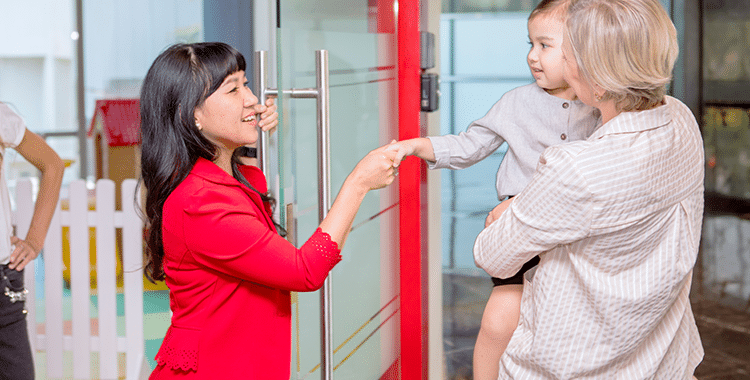If the toddlers in your setting are constantly throwing resources on the floor or waving around sticks, don’t despair. They are likely to be exploring the trajectory schema. Here’s how to set up your environment to create powerful learning opportunities that support children’s schemas.
Children with a trajectory scheme enjoy jumping up and down, throwing things through the air, walking up and down steps, building towers or laying out items such as cars or dominos. It is their way to make sense of the way that objects move through the air, fall and land.Toddlers who start by throwing things on the floor will often move on to drawing in straight lines as they gain a more sophisticated understanding of the concept of trajectory. If done on a repetitive basis, these actions indicate a child’s interest in the trajectory schema. This schema is also linked to early writing as horizontal and vertical movements are needed to form letters.
What are schemas?

Schemas are patterns of repeated behaviour that can be observed in young children’s play as they seek to gain a greater understanding of how the world works. They are an essential part of children’s development because through active learning they begin to process and organise their thoughts and feelings into cognitive structures.
Schemas vary from child to child. Some are interested in how things move up and down, along and back (trajectory). Others have a strong drive to repeat actions such as moving in circles (rotation); moving things from one place to another (transporting); hiding and putting things into containers (containing), connecting and disconnecting toys (connecting) or putting things in particular places (positioning).
Children can show more than one schema at a time so it is essential that practitioners understand that these actions are not random and disconnected and but represent powerful learning opportunities that can be developed, refined and built upon through well-planned continuous provision.
Setting up the environment

Close observation of children’s developing schemas is key. For the trajectory schema, for example, practitioners may observe a child who likes to throw things, bounce items or knock over structures that other children have built. They might be fascinated with the movement of objects through the air. But another child with the same schema may enjoy going up and down the climbing frame, enjoying the feel of his own body as he builds up speed and moves through space.
To support these interests, practitioners can apply the trajectory schema to the whole of the continuous provision. Here are some ideas:
- Babies will enjoy playing with treasure baskets that are filled with interesting objects and containers that they can drop items into.
- In the water and sand play area, include tubes, connectors, pipes, funnels, jugs and basters.
- Outdoors, set up obstacle courses with building blocks, planks, ladders, tyres, cable reels and crates and support them to move over, under, across and through things.
- Provide different sized balls to drop into tubes and guttering, or ramps to run toy cars along.
- Children will love to line up, sort and order collections of items. Ensure that you have plenty of loose parts – leaves, stones, fir cones, cotton reels.
- Things that fly in the air – paper aeroplanes, kites and frisbees – will fascinate them. Watch how they land and support learning around volume and movement.
- Include plenty of mark-making materials – large outdoor chalks, big sheets of paper with sponges, brushes, paint rollers and pipettes for children to explore drawing lines and experimenting with letter formation.
Early schemas

The trajectory schema is one of the earliest schemas observed in babies. This fascination is thought to come from the fact that they are picked up and moved around by parents and carers and they are eager to explore how things move when they become mobile.
The containing schema is another early schema to develop, as the child experiences being wrapped up, swaddled, or strapped into a car seat from birth. Children with this schema love to wrap things up, hide in cardboard boxes and cosy spaces, and fill and empty containers with different objects. It’s not uncommon to see a whole basket of resources dumped onto the floor. But bear with them. Try to provide plenty of baskets, buckets, bags, carts, bottles and boxes for them to fill and empty materials and liquid into.
Those with the transporting schema will load their pockets with sticks and stones and move resources around the setting in the most unexpected ways. They might use bikes, trolleys or prams to transport all the green items they can find and dump them in the sandpit. They use their whole bodies to navigate space, exploring spatial awareness and orientation.
Wheeled toys will be used by others to whizz around in circles as they explore the rotation scheme, which is a fascination with ‘roundness’. They will enjoy spinning their bodies, rolling down slopes and using their hands and fingers to create spiral marks and circles in the sand or with paints.
Children who like to put things together – make jigsaw puzzles, connect pieces of a train track – and disconnect them afterwards, are often exploring the connection schema. Magnets, BRIO building sets and building blocks are good for this schema, as well as fine motor activities such as threading pieces of pasta with string and putting pegs into boards.
Lastly, some children like to line up objects or position them in certain ways. For example, they might group items in line by colour, shape and height or position blocks from small to tall, which represents early grading and links to measuring.
All to play for
Schemas are most often observed when children have the freedom to lead their own play and develop deep connections and awareness of the world around them. Guided by sensitive interactions with ‘tuned in’ practitioners, schematic play has the potential to harness rich learning opportunities.

Nicole
Content Creator



